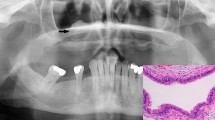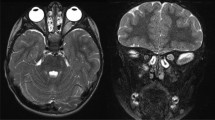Summary
Objective
In adults, supratentorial primitive neuroectodermal tumor (sPNET) is a very rare undifferentiated embryoblastic neoplasm. Prognosis is worse in comparison to infratentorial medulloblastoma. Older age appears to be prognostically favorable. At present, 5-year survival rates remain below 50% in all age groups. Survival longer than 15 years in an adult has only been reported once so far.
Case report
In 1987, a 33-year-old-male patient presented with seizures following a six-month’s history of dizziness. CT- and MRI-scans revealed a right occipital tumor with moderate contrast enhancement. The tumor was completely removed. The original histological diagnosis was that of an undifferentiated sarcoma, malignant hemangioendothelioma, grade III. The patient was treated by CyVADIC chemotherapy and conventional radiation therapy (60 Gy). Admission for another reason in 2003 led to a re-evaluation of the original diagnosis. Microscopy revealed a malignant, highly cellular, poorly differentiated tumor with a desmoplastic component. Up to 20% of tumor nuclei were labeled for Ki-67. Almost all cells were stained for neuron specific enolase and NGF-Rp75, with neuronal and glial markers being present to a variable extent. According to these findings, the diagnosis was changed to a sPNET (WHO IV°). Other tumor entities were excluded by immunohistochemistry.
Conclusions
Although the prognosis of sPNET is reported to be poor, a small fraction with a rather benign biological and clinical behavior exists. Parameters determining long-term-survival in sPNET are not yet known. Whenever possible, complete surgical resection should be attempted followed by postoperative radiotherapy. The value of chemotherapy is an issue of continuous investigation.
Similar content being viewed by others

References
Kaatsch P, Rickert CH, Kuhl J, Schuz J, Michaelis J, 2001 Population-based epidemiologic data on brain tumors in German children Cancer 92: 3155–3164
Balafouta MJ, Kouvaris JR, Miliadou AC, Papacharalampous XN, Kolokouris DV, Kouloulias VE, Mariolis AD, Vlahos LJ, 2002 Primitive neuroectodermal tumour in a 60-year-old man: a case report and literature review Br J Radiol 76: 62–65
Kim DG, Lee DY, Paek SH, Chi JG, Choe G, Jung HW, 2002 Supratentorial primitive neuroectodermal tumors in adults J Neurooncol 60: 43–52
Masuda K, Yutani C, Akutagawa K, Yamamoto S, Hatsuyama H, Ishibashi-Ueda H, Imakita M, Manaka H, Takahashi J, Nagata I, 2000 Cerebral primitive neuroectodermal tumor in an adult male. A case report Acta Cytol 44: 1050–1058
Tripathy LN, Forster DMC, Timperley WR, 1999 Adult primitive neuroectodermal tumour. A case report and review of the literature Br J Neurosurg 13: 90–92
Bellis EH, Salcman M, Bastian FO, 1983 Primitive neuroectodermal tumor in a 57-year-old man Surg Neurol 20: 30–35
Bellis EH, Salcman M, Bastian FO, 1983 Primitive neuroectodermal tumor in a 57-year-old man Surg Neurol 20: 30–35
McNeil DE, Coté TR, Clegg L, Rorke LB, 2002 Incdidence and Trends in Pediatric Malignancies Medulloblastoma/Primitive Neuroectodermal Tumor: a SEER Update Med Pediatr Oncol 39: 190–194
Louis DN, Hochberg FH, 1990 Cerebral primitive neuroectodermal tumor in an adult, with spinal cord metatasis after 18-year dormancy J Neurooncol 9: 77–80
Kleihues P, Cavenee WK (eds): World Health Organization Classification of Tumours. Pathology & Gentics. Tumours of the Nervous System. IARC Press, Lyon, 2000
Albrecht CF, Weiss E, Schulz-Schaeffer W, Albrecht T, Fauser S, Wickbold J, Hess CF, 2003 Primary intraspinal neuroectodermal tumor: report of two cases and rewiew of the literature J Neurooncol 61: 113–120
Pomara G, Cappello F, Cuttano MG, Rappa F, Morelli G, Mancini P, Selli C, 2004 Primitive Neuroectodermal Tumor (PNET) of the kidney: a case report BMC Cancer 4: 3
Rorke LB, 1983 The cerebellar medulloblastoma and its relationship to primitive neuroectodermal tumors. J Neuropathol Exp Neurol 42: 1–15
Frost PJ, Laperriere NJ, Wong CS, Milosevic MF, Simpson WJ, Pintilie M, 1995 Medulloblastoma in Adults Int J Radiat Oncol Biol Phys 32: 951–957
Paulino AC, Melian E, 1999 Medulloblastoma and Supratentorial Primitive Neuroectodermal Tumors: an Institutional Experience Cancer 86: 142–148
Grotzer MA, Geoerger B, Janss AJ, Zhao H, Rorke LB, Phillips PC, 2001 Prognostic significance of Ki-67 (MIB-1) proliferation index in childhood primitive neuroectodermal tumors of the central nervous system Med Pediatr Oncol 36: 268–273
Grotzer MA, Janss AJ, Fung K, Biegel JA, Sutton LN, Rorke LB, Zhao H, Cnaan A, Phillips PC, Lee VM, Trojanowski JQ, 2000 TrkC expression predicts good clinical outcome in primitive neuroectodermal brain tumors J Clin Oncol 18: 1027–1035
Janss AJ, Yachnis AT, Silber JH, Trojanowski JQ, Lee VM, Sutton LN, Perilongo G, Rorke LB, Phillips PC, 1996 Glial differentiation predicts poor clinical outcome in primitive neuroectodermal brain tumors Ann Neurol 39: 481–489
Woodburn RT, Azzarelli B, Montebello JF, Goss IE, 2001 Intense p53 staining is a valuable prognostic indicator for poor prognosis in medulloblastoma/central nervous system primitive neuroectodermal tumors J Neurooncol 52: 57–62
Chan AW, Tarbell NJ, Black PM, Louis DN, Frosch MP, Ancukiewicz M, Chapman P, Loeffler JS, 2000 Adult medulloblastoma: prognostic factors and patterns of relapse Neurosurgery 47: 623–632
Mikaeloff Y, Raquin AN, Lelluch-Tubiana A, Terrier-Lacombe MJ, Zerah M, Bulteau C, Habrand JL, Kalifa C, 1998 Primitive cerebral neuroectodermal tumors excluding medulloblastomas: a retrospective study of 30 cases Pediatr Neurosurg 29: 170–177
Krischer JP, Ragab AH, Kun L, Kim TH, Laurent JP, Boyett JM, Cornell CJ, Link M, Luthy AR, Camitta B, 1991 Nitrogen mustard, vincristine, procarbazine, and prednisone as ajuvant chemotherapy in the treatment of medulloblastoma J Neurosurg 74: 905–909
Wall N, Starkhammer H, 2003 Chemotherapy of soft tissue sarcoma – a clinical evaluation of treatment over 10 years Acta Oncol 42: 55–61
Celli P, Cervoni L, Maraglino C, 1998 Primary rhabdomyosarcoma of the brain: observations on a case with clinical and radiological evidence of cure J Neurooncol 36: 259–267
Dosik GM, Rodriguez V, Benjamin RS Bodey GP, 1978 Neuroblastoma in the adult: effective combination chemotherapy Cancer 41: 56–63
Lopez R, Karakousis C, Rao U, 1980 Treatment of adult neuroblastoma Cancer 45: 840–844
Author information
Authors and Affiliations
Additional information
Supratentorial primitive neuroectodermal tumor is a very rare and highly malignant neoplasm in adults, carrying a poor prognosis. Complete surgical resection followed by radiotherapy proved to be essential for the outcome. We report the case of long-term survival at more than 17 years in an adult patient treated by surgery, postoperative radiation and chemotherapy.
Rights and permissions
About this article
Cite this article
Krampulz, T., Hans, V.H., Oppel, F. et al. Long-term relapse-free survival with supratentorial primitive neuroectodermal tumor in an adult: a case report. J Neurooncol 77, 291–294 (2006). https://doi.org/10.1007/s11060-005-9041-9
Received:
Accepted:
Published:
Issue Date:
DOI: https://doi.org/10.1007/s11060-005-9041-9



